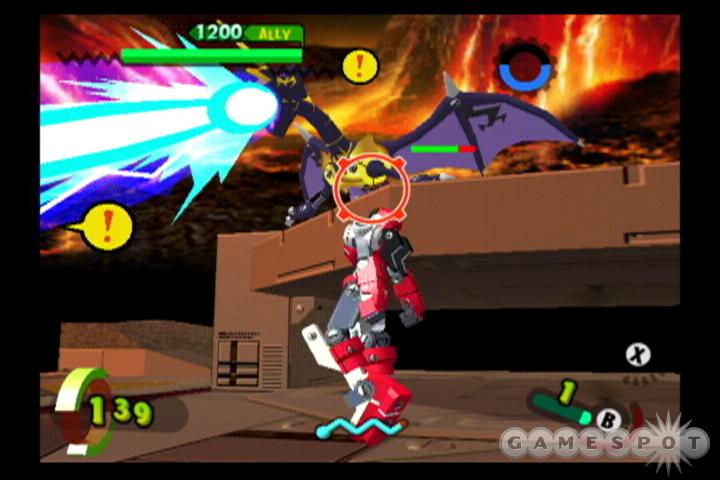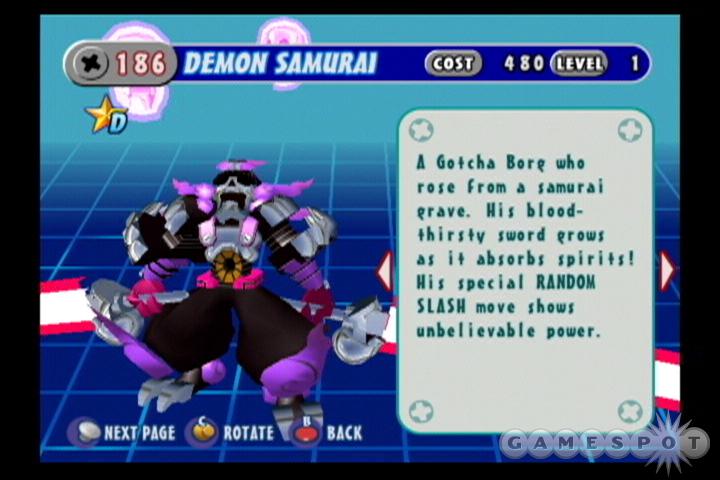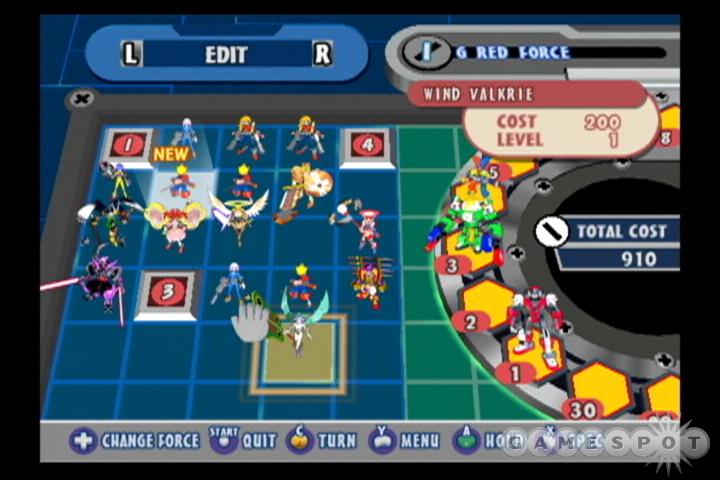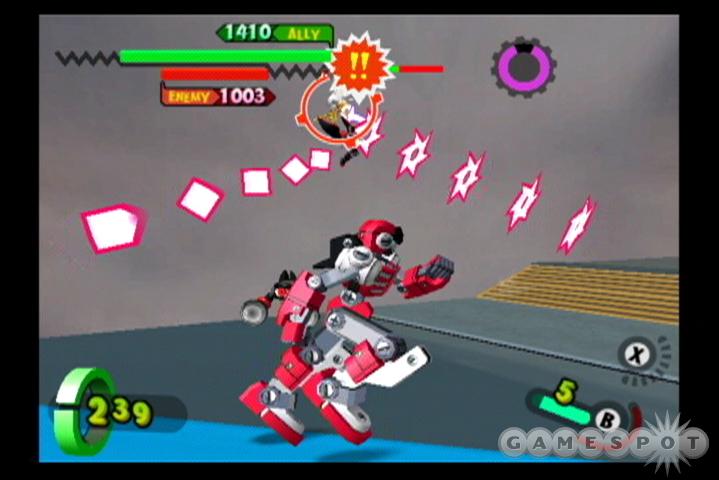If imitation is indeed the sincerest form of flattery, then Pokémon has to have some of the highest self-esteem of any game franchise around. Over the years, a myriad of different imitators have tried to re-create the monster training, trading, and collecting formula that Pokémon essentially turned into a phenomenon. Capcom has now become the latest company to tip its hat to Pokémon with its development of Gotcha Force for the GameCube. Gotcha Force revolves around a group of anime-faced kids who command not monsters, but tiny robots who are out to save or destroy the world. Whether the robots save or destroy the world depends on which faction they belong to--be it the heroic Gotcha Force or the evil Death Force. Gotcha Force's gameplay is decidedly more action-oriented than its monster-training inspiration and actually seems to draw the bulk of its influence from Capcom's Power Stone series. Unfortunately, Gotcha Force really doesn't emulate Pokémon or Power Stone very well. Instead, it comes off as a pale, perfunctory imitation of both that crutches itself far too heavily on brainless, clunky, spastic action that doesn't so much entertain as it bewilders.

There are three gameplay modes available in Gotcha Force--the primary of which is the story mode. As mentioned before, the story of Gotcha Force involves warring factions of robots, who are referred to as Borgs. The story opens up with the game's hero, Kou, meeting G-Red, a Gotcha Borg who has come to earth to seek out and destroy the Death Force and its leader, the Galactic Emperor. G-Red asks Kou to be his commander, and from there, the battle is on. Along the way, you meet numerous other youngsters with their own rosters of Borgs, some of whom will become your allies and others who are out to simply antagonize you. Battles are determined by friend or foe location on a map of Kou's city, Safari Town, which is divided into sections. Trouble spots are denoted by an exclamation point, in addition to an icon that either represents Death Force or one of the other commander kids. How you progress is essentially open-ended, but the story itself moves in a fairly linear fashion.
Battles in Gotcha Force are team-based but in sort of a unique way. As you go through each battle, you consistently earn energy, which can be used to store more Gotcha Borgs (which can be acquired throughout the story mode). Each Gotcha Borg costs a certain amount of energy, so you can only have as many Borgs as your energy level will allow--with up to 30 available for a team. Actual combat begins with one of your Gotcha Borgs or one of your Gotcha Borgs and one of your allied commanders' Borgs. If your Borg is destroyed while the battle rages, then the next one you have lined up on your team jumps in. The same goes for your allies, and the same goes for your enemies. Whoever's side has the last remaining Borgs standing wins the battle. As there are more than 280 different Borgs you can collect in Gotcha Force, it may seem like this ability to combine near-limitless types of teams would make for a highly varied type of gameplay experience. Sadly, the game's actual combat pretty much kills that notion right off.

Your basic battle controls in Gotcha Force involve the B and X buttons for attacks and the A button for jumping. Every type of Borg in the game has its own unique form of attack, but most of them are just variations on the same basic hack-and-slash, projectile attack, and dash-attack moves. You can also target specific enemies by using the right and left trigger buttons. Everything during combat moves at an extremely feverish pace, so basically, the only real strategy to your attacks should involve locking on to the enemy closest to you, hitting the attack buttons as many times as you can until the enemy's dead, and then allowing the game to auto-lock on to the next enemy for you. Then, just lather, rinse, and repeat until the next opponent is dead. As the game goes on, enemies do get a bit harder, but really, all you have to do is just occasionally dodge their slightly more-focused and damaging attacks, which, all told, isn't hard at all.
Ultimately, the biggest challenge in Gotcha Force's combat comes from just trying to figure out what the heck is going on at any given point. Gotcha Force is incredibly fast-paced, but more often than not, this speed serves less to keep things exciting and serves more to just completely obliterate whatever attention span you might have had going into the game. Much of this has to do with the game's practically seizure-inducing camera. All the Borgs move around very quickly, and once you've destroyed an enemy, the camera will sharply and suddenly jerk to a new angle to shift your focus on to the next target. Since a lot of the lesser enemies only take a scant few hits to kill, you can find yourself in a position where the camera will continuously jerk around--all over the place--as you mow through the opposition. This is highly disconcerting, to say the least. It's often very hard to tell if you're actually hitting an enemy or not, so there's simply no predicting where the camera may shift next. On top of its abrupt movements, the camera also has an inconceivably dumb habit of moving underneath the floor of the battle environment, as well as getting stuck in some really awful angles. This was seemingly intended to make targeting airborne enemies a little easier, but what it actually succeeds in doing is adding the final straw that breaks an already shallow, obnoxious, and deeply unhinged gameplay experience.

The rest of the game's modes would otherwise be a welcome addition to the story mode, were they not rooted in Gotcha Force's irritating gameplay structure. Challenge mode is a progressive battle mode where you simply take on wave after wave of enemies until you either get to the end or you die. Versus mode is for 1-4 players and lets you and your friends go up against one another in a typical battle. The one unique thing about the versus mode is that it also lets you input multiple memory cards, so your friends can use their own custom Gotcha Borg teams in battle. Unfortunately, versus mode doesn't play any better than the rest of the game, and, in a sense, it's actually worse--especially since the varying forms of split-screen used serve to only make the action that much more confusing. Additionally, the frame rate is cut by about one-half when playing with four players. Outside of gameplay, Gotcha Force has a few other modes, like a collection mode that lets you view the specs and stats of your collected Borgs. There's also a trade mode that allows you to swap Borgs with your friends through memory cards. These modes are nice to have around, but considering the game isn't fun to begin with, they're ultimately kind of meaningless.
Gotcha Force's graphics aren't much worth praising either. Aside from the aforementioned camera problems, the game's method of animation lends itself to the incoherency of the combat as well. Your Borgs move around in a pretty stuttery fashion, and a lot of their move and attack animations just don't look very good at all. The battle arenas in the game look flat-out bad and essentially reuse the same flat, ugly environments but include a few changed set pieces and some needless destructible boxes here and there. Most of the assorted energy blasts and explosions look rather cheap as well, and, overall, the action just has an entirely low-rent feel. The one shining spot amid the rough graphics are the Borg models, which are varied, uniquely designed, and, in some cases, very cool-looking. Furthermore, significantly more polish has clearly gone into the models, as opposed to everything else in the game. Aside from the frame rate performance issues in the multiplayer, the game runs pretty smoothly otherwise.

The game's sound quality is just as grating as its action. Loud music blares during every menu screen and during combat. Thankfully, though, you can turn it off in the options menu. There's not much voice acting to be found in the game, but what is there isn't good. Some of the voices for the kids are OK, though they're definitely very wooden and emotionless in their delivery. In a way, this seems as though it was done intentionally. Other kids are just kind of irritating to listen to, and G-Red's voice (apparently the fusion of a human voice and some sort of robot vocoder effect), is especially bad. Some of the in-game sound effects are decent enough, like the array of explosions and laser sounds found throughout, but none of them are especially good in any way. All told, Gotcha Force really just isn't pleasant to listen to in any regard.
The excuse could be made that because Gotcha Force is a game that's primarily aimed at younger kids, its flaws aren't as important. In reality, however, it's really hard to find anything to like about Gotcha Force, regardless of age. There's just not enough here to appeal to anyone who isn't a serious hardcore monster/robot/monster-robot collection fan, and even if you are, there are far better choices available.